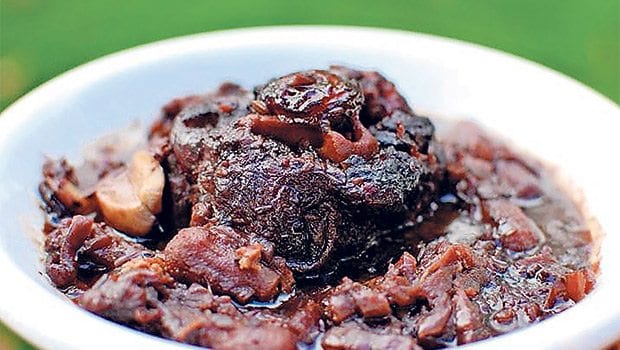
We like our meat tender, and we like our meat juicy. And we like it easy to prepare, too. If you’ve got the money for steak, then just don’t overcook it, and you will have soft and juicy, with ease.
But you might be surprised to learn that those prestigious pieces are among the least flavorful of cuts, well behind the ones that you can’t even chew.
The most flavor resides in the least-expensive cuts like shank, chuck, shoulder, brisket, flank and, if you can get it, neck. These keep their flavor hidden in their collagen, the tough, protein-rich gristle that crisscrosses the chewier cuts of meat, and holds all of the meaty fibers together.
The only way to truly enjoy the pleasures of collagen is to melt it into a what is called gelatin. While uncooked collagen chews like a snow tire, gelatin is soft, with a creamy mouthfeel that adds fat-like lubricity as you chew.
The question is, how do we melt that gristle without letting the meat dry out? It’s a bit of a trick, but the methods are many.
A bit of science
Collagen will begin to melt in temperatures as low as 160 degrees, which is easy to achieve in the kitchen. But it’s the amount of time spent above this low threshold, rather than the temperature itself, that erodes the rigid collagen structure into its soupy alter-nutrient. As the collagen dissolves, the muscle fibers it once held tightly begin to burst from its grasp, as it achieves the famous falling-apart-tender state.
To a certain extent, acid helps break down collagen as well. Some vinegar in the stew pot, a long, tangy marinade for the flank steak or some wine in the braise will all help speed the process.
All of these methods, in their own way, deal with the problem that collagen doesn’t melt below 160 but meat begins to dry out above 130. Barbecuers baste continuously with their vinegary sauce. Soup makers and braisers do their business underwater.
I’ve been enjoying a technique by which I wrap my meat tightly in tin foil, push it into the oven, and forget about it. This setup essentially steams the meat in its own juices, injecting the moisture right back into the meat as it tries to escape.
The other day I took a hunk of bone-in elk shank from the freezer and immediately wrapped it in foil, still frozen solid. Into the oven it went, at 325. I proceeded to forget about it for the rest of the day. No salt, no herbs, no additions of any kind. It came out divine, but was not so much a finished product as a worthy ingredient. With added salt, raw onions and cilantro on tacos, it wore the salsa like a champ.
One can get quite creative about foiling meat in such a way that it comes out ready to eat – a flavorful, satisfying product that needs nothing but a glass of wine alongside it.
Brining the meat first in salt water will help it retain even more moisture. And if you put your hunk of collagen- reinforced meat under the broiler, a tasty, crispy brown skin will develop. This will help contain the juices to an extent, and will add a caramelized complexity that only browned proteins can muster.
Add flavorings before you foil it. Lemon and dried apricots and harissa and olive oil, if you want a North African feel, or cumin and red chile if you liked the sound of those tacos, or rosemary, thyme and olive oil if you want something like an osso bucco.
When you have your flavorings figured out, tightly foil your brined, browned meat. As it cooks, some juices will inevitably find their way out, but the fewer the better.
When that gelatin-rich liquid begins weeping from the foil, don’t let it go to waste. A way to harvest those escaping juices is to pave the bottom of the baking pan with sliced roots and tubers, like potato, carrot, parsnip, celeriac, onion and garlic. They will put those juices to good use by soaking them up, as any Thanksgiving veteran knows.
Ari LeVaux writes Flash in the Pan, a syndicated weekly food column that’s appeared in more than 50 newspapers in 25 states. Ari lives can be reached at flash@flashinthepan.net.






